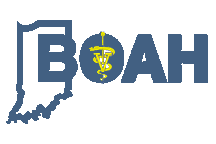When an Indiana premises is identified with highly pathogenic avian influenza (HPAI), on-the-ground response efforts begin immediately. Animal health officials carry out a number of activities according to protocols established by the U. S. Department of Agriculture in order to manage the disease and reduce any potential risk of its spread. These activities take place not only on the affected premises, but also in a control area around the affected premises.
Affected Site
Premises infected with HPAI are placed under quarantine, prohibiting the movement of poultry and poultry products on or off of the affected site. The USDA and the Indiana Board of Animal Health (BOAH) work with infected flock owners to develop a flock plan which includes appraisal and indemnity agreements for depopulation of poultry on the affected premises. After depopulation of the flock, all poultry remains and other potentially infected materials on the affected farms are safely disposed of according to USDA/BOAH guidelines.
Control Area
The control area is a 10 km (6.2 mile) zone that is established around infected flocks and includes two zones: infected and buffer.
Infected zone, a 3-km (1.9-mile) radius around the infected site: all backyard flocks are officially quarantined. Live and dead poultry and poultry products cannot be moved on or off a premises without a BOAH-approved movement permit. Each flock must complete two rounds of surveillance testing, with negative results before quarantines can be lifted.
Buffer zone, an additional 7-km (4.3-mile) radius around the infected zone: poultry owners cannot move live or dead poultry or poultry products on or off of their premises without a BOAH-approved movement permit.
Commercial flocks inside of the control area undergo surveillance in accordance with U. S. Department of Agriculture protocols. All commercial poultry producers in the control area also comply with stringent biosecurity and permitting protocols in order to move poultry or poultry products off of their farms.
